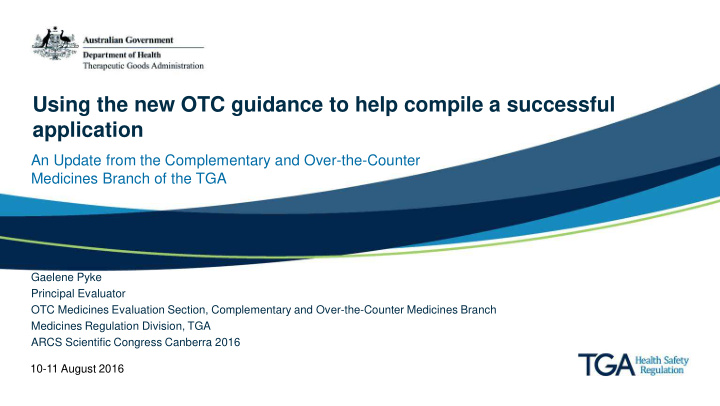



Using the new OTC guidance to help compile a successful application An Update from the Complementary and Over-the-Counter Medicines Branch of the TGA Gaelene Pyke Principal Evaluator OTC Medicines Evaluation Section, Complementary and Over-the-Counter Medicines Branch Medicines Regulation Division, TGA ARCS Scientific Congress Canberra 2016 10-11 August 2016
Overview Provide an outline of the OTC guidance documents you need to be very familiar with, where to find them on the TGA website, briefly explain how they should be used to assist in compiling a successful OTC application: • Purpose of OTC guidance documents • Background to new guidance • Location • Key aspects for preparing an effective OTC application • Benefits Using the new OTC guidance to help compile 1 a successful application
Purpose of OTC guidance documents OTC guidance documents assist applicants with the process of applying to either register a new OTC medicine or make changes to the registration details of a currently registered OTC medicine • Explains the process involved in: - registering a new medicine application - changing a registered medicine • Identifying correct application level • Identification of data/information requirements • Cover letter • Format of dossier Using the new OTC guidance to help compile a successful application 2
Background to new guidance • New business process for OTC medicines commenced in 2013 following extensive consultation with industry and stakeholders – Staged implementation over 12 months • New OTC guidance documents needed to be developed and some existing guidance documents required updating to: – Reflect changes to OTC business processes – Provide greater clarity around data and application requirements – Improve readability and accessibility Using the new OTC guidance to help compile a successful application 3
Location of guidance • ARGOM landing page Using the new OTC guidance to help compile a successful application 4
Key aspects for preparing an effective OTC application • For ‘new’ medicines, verify proposed medicine is an OTC • Identify application level • Identify required supporting data and information • Cover letter • CTD format • Screening Using the new OTC guidance to help compile a successful application 5
Key aspects: processes for new and change applications • Understanding the processes – use the step-by-step guides Using the new OTC guidance to help compile a successful application 6
Key aspects: processes for new and change applications New registration applications • steps in the OTC registration process for new medicine applications Using the new OTC guidance to help compile a successful application 7
Key aspects: processes for new and change applications Change applications • steps in the process to change a registered OTC medicine Using the new OTC guidance to help compile a successful application 8
Key aspects: identify application level • Determining your application level • Appropriate change codes for change applications Using the new OTC guidance to help compile a successful application 9
Key aspects: identify application level • Appropriate change codes for change applications Using the new OTC guidance to help compile a successful application 10
Key aspects: identify required supporting data and information • Mandatory requirements for an effective application • CTD Module 1: OTC medicines • Specific technical guidance for OTC medicines • Assurances for N1 applications • N2 application requirements • General TGA medicines guidance • EU and ICH guidance Using the new OTC guidance to help compile a successful application 11
Key aspects: identify required supporting data and information ARGOM landing page - ‘Supporting information’ Using the new OTC guidance to help compile a successful application 12
Key aspects: identify required supporting data and information ARGOM landing page - ‘Supporting information’ Using the new OTC guidance to help compile a successful application 13
Key aspects: cover letter • Cover letter: – Nature and scope of application – Details to be included – Include in Module 1.0.1 • Assists with screening process Using the new OTC guidance to help compile a successful application 14
Key aspects: format • Must be in CTD format Refer to – General dossier requirements – Common Technical Documentation (CTD) Using the new OTC guidance to help compile a successful application 15
Key aspects: screening • Applications are screened by TGA to ensure: – Is for an OTC medicine – Correct application level – Submitted in correct format – Mandatory requirements have been met – Cover letter accurately describes nature and purpose of application Using the new OTC guidance to help compile a successful application 16
Key aspects: screening • Applications will not be accepted for evaluation if Mandatory requirements are not met • Use of OTC guidance documents will minimise the chances of an application not being accepted Using the new OTC guidance to help compile a successful application 17
Benefits • Provide greater clarity and understanding of application and data requirements • Improved readability and accessibility Careful use of new and revised OTC guidance documents by applicants • Significant improvements in the quality of applications submitted to the TGA • Potential to reduce evaluation timeframe • Increases likelihood of applications being successful Using the new OTC guidance to help compile a successful application 18
Summary • Be familiar with the OTC guidance documents and Mandatory requirements for an effective application • Follow them carefully • Check application against guidelines when compiling and prior to submitting • Applications that are consistent with guidelines are more likely to have shorter evaluation times and be successful Using the new OTC guidance to help compile a successful application 19
Recommend
More recommend